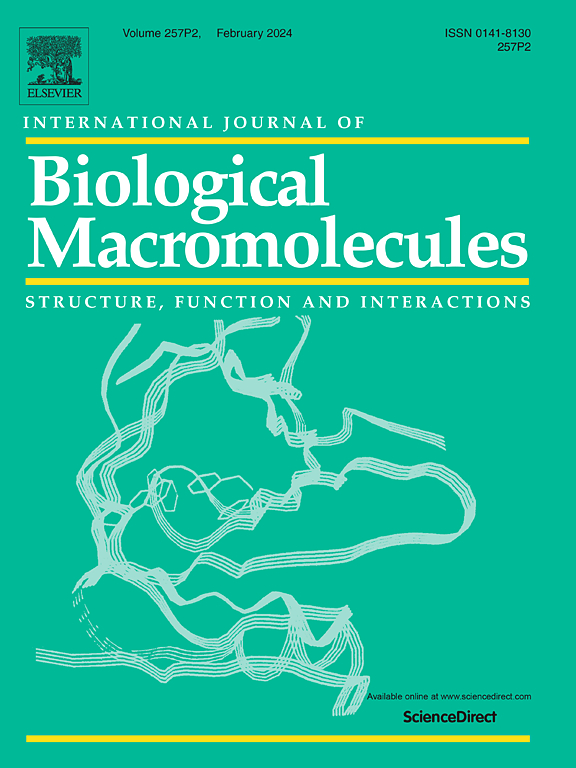Multifunctional poly(lactic acid) membrane assisted by coal-based carbon dots for efficient separation of oil-in-water emulsions and dyes
IF 8.5
1区 化学
Q1 BIOCHEMISTRY & MOLECULAR BIOLOGY
International Journal of Biological Macromolecules
Pub Date : 2025-04-01
DOI:10.1016/j.ijbiomac.2025.142755
引用次数: 0
Abstract
Superhydrophilic separation membranes have broad application prospects in oil-water separation and wastewater purification. However, the accumulation of pollutants on the membrane surface and the secondary environmental pollution caused by waste membranes remain inevitable challenges. In this study, a superhydrophilic self-cleaning multifunctional membrane was fabricated by hydrolytic co-deposition of carbon dots, tetrabutyl titanate (TBT), and tannic acid on the surface of a degradable poly(lactic acid) (PLA) membrane for efficient separation of dye/oil/water emulsions. The results indicate that the superhydrophilic crosslinking network is formed on the surface of PLA-based membranes through co-deposition of TA-based coating, enabling the multifunctional membrane to possess a stable and ultra-strong oleophobic hydrophilic layer. As a result, the membrane exhibits strong underwater oil resistance and excellent performance in the separation of oil-in-water emulsions (rejection rate > 99%). More importantly, the surface of the superhydrophilic crosslinking network is negatively charged, which facilitates the selective removal of positively charged organic soluble substances in water through electrostatic adsorption. For instance, the removal rate of cationic dye MB and amphoteric dye RhB can reach as high as 99.93%. Additionally, with the catalysis of TiO2, the organic pollutants on the membrane surface can be decomposed under UV irradiation, indicating the ideal self-cleaning property of the multifunctional membrane. This novel strategy for constructing a multifunctional surface deposition layer is expected to provide broader prospects for the application of superhydrophilic membranes in oil-water separation and wastewater purification.

煤基碳点辅助多功能聚乳酸膜高效分离水包油乳剂和染料
超亲水分离膜在油水分离和废水净化方面具有广阔的应用前景。然而,污染物在膜表面的积累和废膜对环境的二次污染仍然是不可避免的挑战。本研究将碳点、钛酸四丁酯(TBT)和单宁酸水解共沉积在可降解聚乳酸(PLA)膜表面,制备了一种超亲水性自清洁多功能膜,用于高效分离染料/油/水乳液。结果表明,聚乳酸基膜通过共沉积ta基涂层,在聚乳酸基膜表面形成超亲水交联网络,使多功能膜具有稳定的超强疏油亲水层。结果表明,该膜具有较强的水下抗油性能和较好的水包油乳剂分离性能(去除率>;99%)。更重要的是,超亲水交联网络表面带负电,有利于通过静电吸附选择性去除水中带正电的有机可溶性物质。例如,阳离子染料MB和两性染料RhB的去除率高达99.93%。此外,在TiO2的催化作用下,膜表面的有机污染物在紫外线照射下可以被分解,表明多功能膜具有理想的自清洁性能。这种构建多功能表面沉积层的新策略有望为超亲水性膜在油水分离和废水净化中的应用提供更广阔的前景。
本文章由计算机程序翻译,如有差异,请以英文原文为准。
求助全文
约1分钟内获得全文
求助全文
来源期刊
CiteScore
13.70
自引率
9.80%
发文量
2728
审稿时长
64 days
期刊介绍:
The International Journal of Biological Macromolecules is a well-established international journal dedicated to research on the chemical and biological aspects of natural macromolecules. Focusing on proteins, macromolecular carbohydrates, glycoproteins, proteoglycans, lignins, biological poly-acids, and nucleic acids, the journal presents the latest findings in molecular structure, properties, biological activities, interactions, modifications, and functional properties. Papers must offer new and novel insights, encompassing related model systems, structural conformational studies, theoretical developments, and analytical techniques. Each paper is required to primarily focus on at least one named biological macromolecule, reflected in the title, abstract, and text.

 求助内容:
求助内容: 应助结果提醒方式:
应助结果提醒方式:


